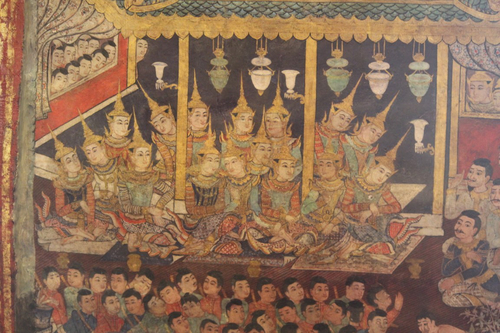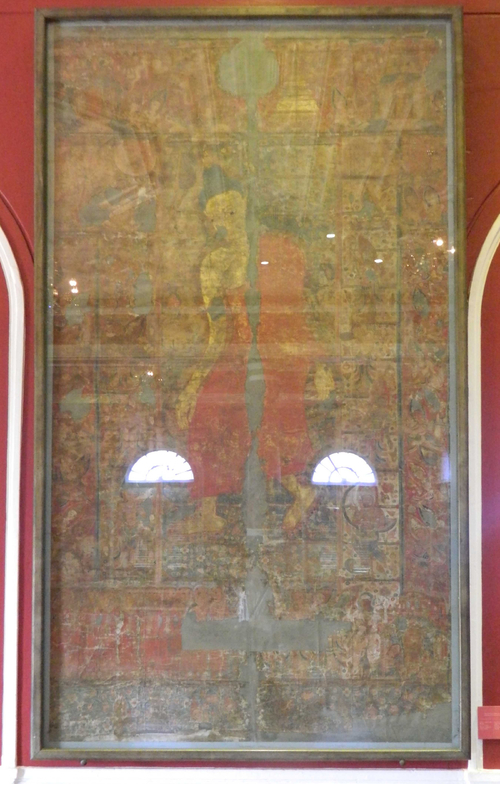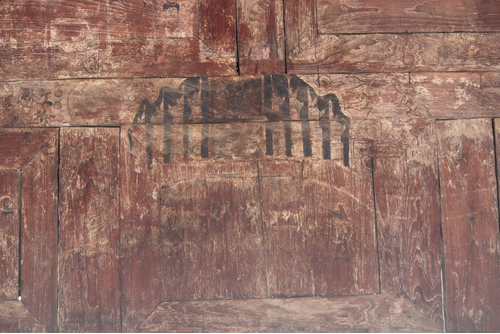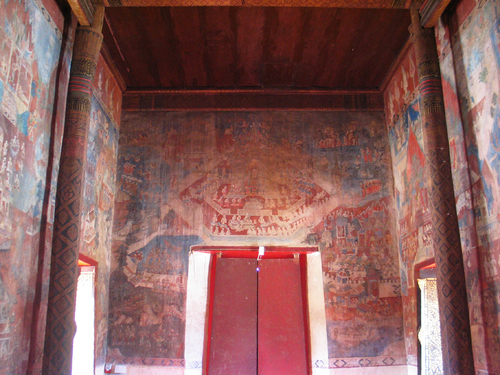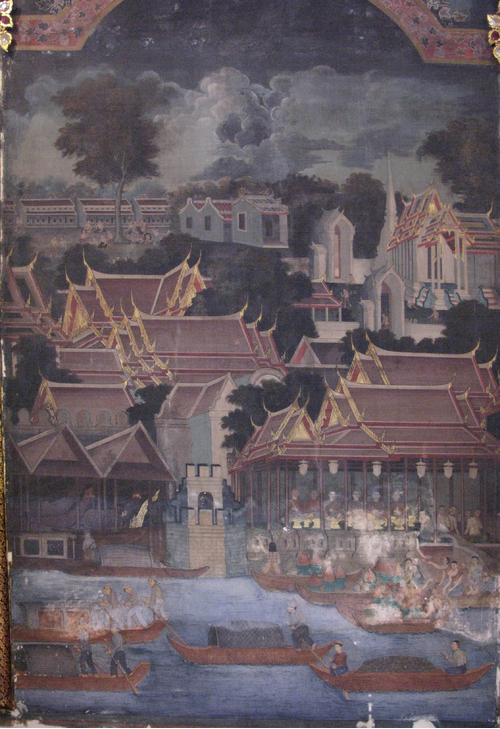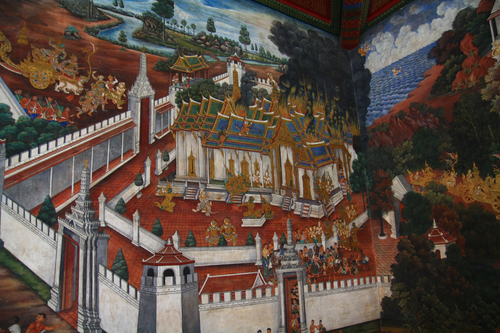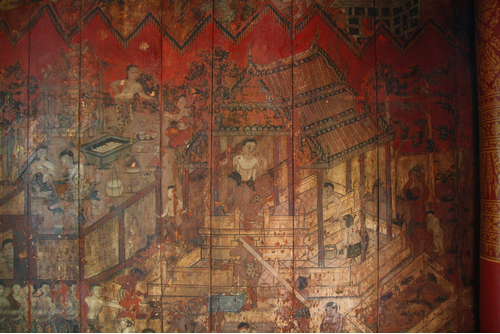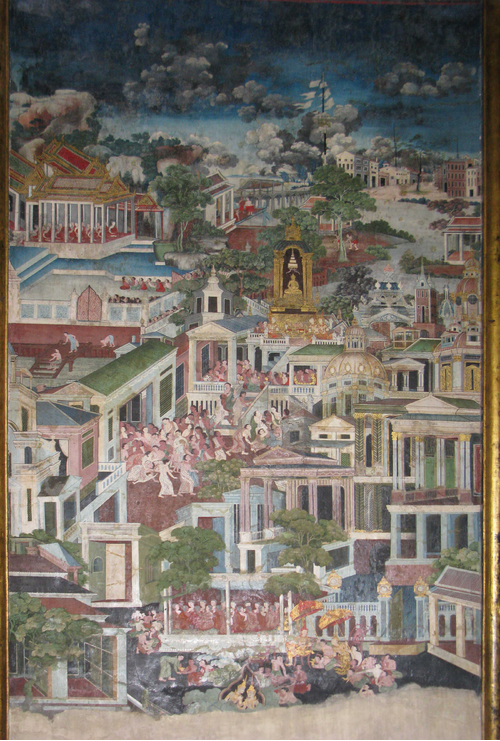ค้นหางานศิลปกรรม
ฐานข้อมูลศิลปกรรมในเอเชียตะวันออกเฉียงใต้
จิตรกรรมจิตรกรรมฝาผนังในวิหารลายคำ
จิตรกรรมฝาผนังที่วิหารลายคำมีหลายส่วน บริเวณผนังห้องท้ายวิหารเขียนภาพพระอดีตพุทธเจ้าเรียงแถว ผนังด้านทิศเหนือเขียนเรื่องสุวรรณหงส์ ผนังด้านทิศใต้เขียนเรื่องสังข์ทอง เหนือเรื่องสุวรรณหงส์และสังข์ทองเขียนภาพเทพชุมนุม โดยลักษณะภาพที่ปรากฏมีลักษณะเป็นแบบ 3 มิติและมึความสมจริงยิ่งขึ้นซึ่งเป็นอิทธิพลจากศิลปะรัตนโกสินทร์ที่ได้รับอิทธิพลจากตะวันตกและมีอิทธิพลจากศิลปะพม่า เช่นลักษณะสถาปัตยกรรมทรงปยาทาดหรือเครื่องทรงกษัตริย์ต่างๆและมีการเขียนภาพกากที่บอกเล่าวิถีชีวิตของชาวบ้านในปริมาณที่มากกว่าจิตรกรรมฝาผนังในภาคกลาง
จิตรกรรมพระบฏวัดดอกเงิน
พระบฏผืนนี้เขียนเรื่องพระพุทธเจ้าเสด็จลงจากสวรรค์ชั้นดาวดึงส์สู่เมืองสังกัสสะ สีที่ใช้มีหลายสี เช่น สีเขียว สีน้ำเงิน สีแดง สีขาว สีดินเหลืองและสีดำ ปิดทองเฉพาะองค์พระพุทธเจ้า ภาพแบ่งออกเป็น 4 ช่วง ช่วงบนสุดเป็นภาพสวรรค์ชั้นดาวดึงส์ แสดงภาพเทวดาประคองอัญชลี มีต้นปาริชาติ เจดีย์จุฬามณี และวิมาน 2 หลังคือเวชยันต์ปราสาทและสุธรรมเทวสภา ชั้นที่สองเป็นภาพพระพุทธเจ้าขนาดใหญ่อิริยาบถลีลาลงจากบันไดแก้ว มีพระอาทิตย์และพระจันทร์ขนาบสองข้างพระเศียร ด้านซ้ายแสดงภาพเทวดาจากสวรรค์ชั้นดาวดึงส์เสด็จลงบันไดเงิน ด้านขวาแสดงภาพพรหมเสด็จลงบันไดทอง ขอบทั้งสองด้านแสดงภาพเทวดาชั้นรองถือเครื่องสักการะเหาะตามมา ชั้นที่สามแสดงภาพเมืองสังกัสสะ ฝั่งขวาคือแถวพระสงฆ์ ฝั่งซ้ายคือกลุ่มกษัตริย์ยืนรอรับเสด็จ และยังมีภาพบุคคลอื่นๆ เช่น พราหมณ์ ขุนนางประคองอัญชลีและมีภาพปราสาท ด้านล่างสุดเป็นภาพน้ำ มีมนุษยนาคประคองอัญชลี ฉากหลังเป็นดอกมณฑารพ มีจารึกอักษรฝักขามตามตำแหน่งต่างๆ
จิตรกรรมจิตรกรรมฝาผนังในวิหารน้ำแต้ม
ลักษณะในการเขียนจิตรกรรมในวิหารน้ำแต้มใช้สีพหุรงค์ประด้วยสีแดง สีเขียวเหลือง สีดำและขาว ตัวบุคคลชั้นสูงแต่งกายแบบพม่า ชาวบ้านแต่งกายแบบพื้นเมืองล้านนาและพม่า ภาพทิวทัศน์แสดงแนวเส้นเลื่อนไหล มีเส้นแบ่งภาพเป็นเส้นโค้ง มีจารึกบอกเรื่องราวเป็นอักษรธรรมล้านนา เรื่องราวที่เขียนเป็นเรื่องมาฆมาณพหรือประวัติพระอินทร์ และเรื่องสามาวดีซึ่งเป็นเรื่องราวในอรรถกถาบาลี มีการเขียนภาพไตรภูมิ ซึ่งแสดงเป็นแท่งเสา ตรงกลางเป็นวิมานของพระอินทร์ในสุทัศนนครบนสวรรค์ชั้นดาวดึงส์ มีพระอาทิตย์และพระจันทร์โคจรอยู่รอบๆ
จิตรกรรมจิตรกรรมฝาผนัง วัดทุ่งศรีเมือง
จิตรกรรมฝาผนังที่หอพระพุทธบาทนี้มีการเขียนทั้งบนผนัง บานแผละ และเสา ที่ผนังเขียนเรื่องพระเวสสันดรชาดก พระมาลัย และพุทธประวัติ ที่บานแผละเขียนเรื่องปาจิตตกุมารชาดก จุลปทมุชาดกและสินไซ ที่เสาเขียนเรื่องสินไซ ลายเครือเถาและลายพุ่มข้าวบิณฑ์ โดยภาพจิตรกรรมแสดงเทคนิคที่น่าจะได้รับถ่ายทอดมาจากช่างหลวงในกรุงเทพมหานคร เช่น การเขียนตัวพระ-ตัวนาง การเขียนปราสาทราชวัง วรรณะสีแต่ก็มีการแทรกภาพวิถีชีวิตของชาวบ้านหรือภาพกากลงไปด้วย
จิตรกรรมจิตรกรรมเรื่องพระราชพิธีสิบสองเดือน
ภาพพระราชพิธีในแต่ละเดือนเขียนขึ้นที่ผนังระหว่างช่องหน้าต่าง โดยปรากฏอิทธิพลการเขียนภาพแบบตะวันตกแล้ว กล่าวคือ มีการใช้เส้นขอบฟ้า กำหนดมิติของภาพให้เกิดระยะที่ใกล้-ไกล ภาพทิวทัศน์ เช่น ท้องฟ้า ก้อนเมฆ ต้นไม้เขียนขึ้นโดยคำนึงถึงความสมจริง ภาพอาคารสถานที่ซึ่งเป็นสถานที่ประกอบพระราชพิธีมักเป็นพระมหาปราสาทและอาคารต่างๆที่มีอยู่จริงในพระบรมมหาราชวังและพื้นที่ใกล้เคียง เช่น บริเวณท่าราชวรดิษฐ์ที่ประกอบด้วยป้อมและหมู่พระที่นั่งต่างๆ ซึ่งปัจจุบันไม่เหลือหลักฐานแล้ว ภาพการโล้ชิงช้าที่เสาชิงช้าหน้าโบสถ์พราหมณ์ เป็นต้น ภาพบุคคลแต่งกายตามสถานภาพ มีทั้งที่เป็นทหารใส่เครื่องแบบที่พัฒนาการตะวันตก ภาพชาววังและชาวบ้านที่แต่งกายตามสมัยนิยม รวมทั้งชาวต่างชาติที่มีอยู่ในสังคมขณะนั้น การลงสีมีการแรเงา ไล่น้ำหนักสีอ่อนแก่ ภาพบุคคลมีขนาดเล็กเมือเทียบกับภาพสถาปัตยกรรม มีความพยายามเขียนภาพเหมือนบุคคลขนาดเล็กด้วย
จิตรกรรมจิตรกรรมฝาผนังเรื่องรามเกียรติ์
จิตรกรรมแบบไทยประเพณีผสมผสานกับเทคนิคการเขียนภาพแบบสมัยใหม่ ลักษณะที่แสดงถึงความเป็นจิตรกรรมไทยแบบประเพณี ได้แก่ ภาพบุคคลในเรื่องที่เป็นตัวละคนสำคัญแต่งกายยืนเครื่องเช่นเดียวกับการแต่งกายในการแสดงโขน กิริยาอาการอยู่ในท่านาฏลักษณ์ มีการปิดทองคำเปลวที่เครื่องทรงของตัวละครที่สำคัญ เป็นต้น ส่วนเทคนิคการเขียนภาพแบบใหม่ที่แตกต่างจากจิตรกรรมไทยประเพณี ได้แก่ การกำหนดเส้นขอบฟ้าและวางระยะของวัตถุในภาพทำให้เกิดมิติ การเขียนภาพเหมือนของอาคารสถานที่ที่มีอยู่จริง เช่น พระมหาปราสาทในพระบรมมหาราชวัง และการเขียนภาพทิวทัศน์ต่างๆ อย่างเหมือนจริง นอกจากนี้ ยังมีการสอดแทรกเรื่องราววิถีชีวิตชาววัง ชาวบ้าน และอารมณ์ขันต่างๆ ผ่านตัวละครประกอบของเรื่อง จิตรกรรมฝาผนังมีทั้งสิ้น 178 ห้องภาพ ใต้ภาพมีโคลงเรื่องรามเกียรติ์ประกอบ รวมทั้งสิ้น 224 บท
จิตรกรรมจิตรกรรมฝาผนัง หอไตรวัดระฆังโฆสิตาราม
จิตรกรรมฝาผนังมีรูปแบบอย่างจิตรกรรมไทยประเพณีที่สืบเนื่องมาจากสมัยอยุธยา เขียนด้วยสีฝุ่นบนผนังพื้นไม้ มีลักษณะสำคัญ เช่น ใช้เส้นสินเทาคั่นฉาก โดยใช้สีแดงเป็นพื้นหลัง เพื่อขับเน้นให้ภาพบุคคลและวัตถุอื่นซึ่งมีสีอ่อนกว่าโดดเด่นขึ้น การเขียนภาพเป็นแบบระบายสีและตัดเส้น ภาพบุคลสำคัญใช้สีอ่อน ส่วนภาพบุคคลชั้นรองใช้สีเข้มกว่า
จิตรกรรมจิตรกรรมเรื่องพระพุทธสิหิงค์
จิตรกรรมเรื่องพระพุทธสิหิงค์เขียนบริเวณผนังระหว่างช่องหน้าต่าง แบ่งองค์ประกอบภาพเป็นกลุ่มๆโดยมีแนวภูเขา ต้นไม้ แม่น้ำ และสถาปัตยกรรมต่างๆ ที่มีทั้งแบบไทย จีน และตะวันตก เป็นแนวแบ่งกลุ่มภาพเพื่อเล่าเหตุการณ์ที่สำคัญของเรื่อง มีภาพธรรมชาติและทิวทัศน์เป็นฉากหลัง มีการแสดงระยะใกล้-ไกล และใช้เส้นขอบฟ้า ซึ่งลักษณะเหล่านี้บ่งบอกถึงอิทธิพลจากศิลปะตะวันตกที่เข้ามาในช่วงรัชกาลที่ 3-4
